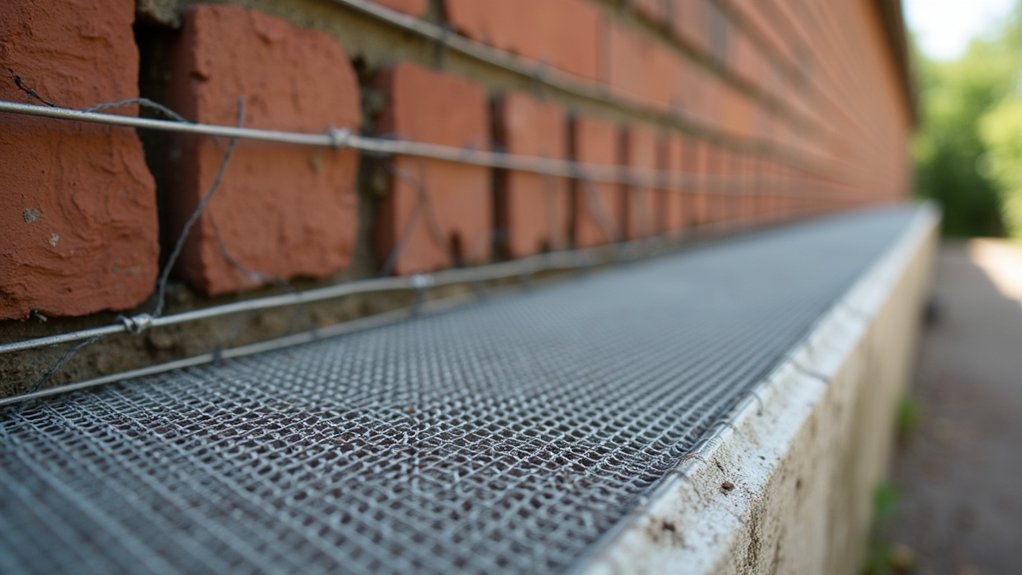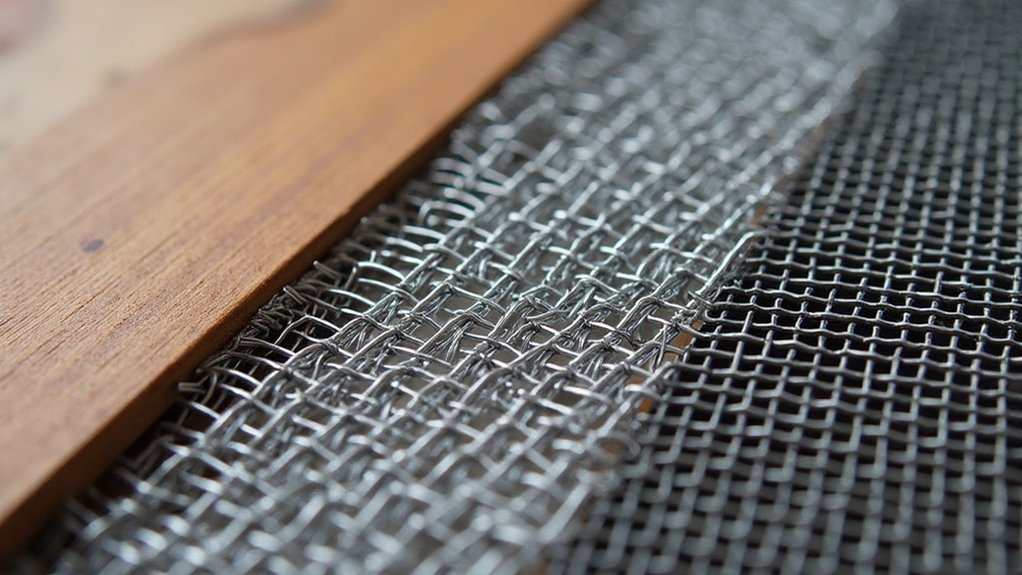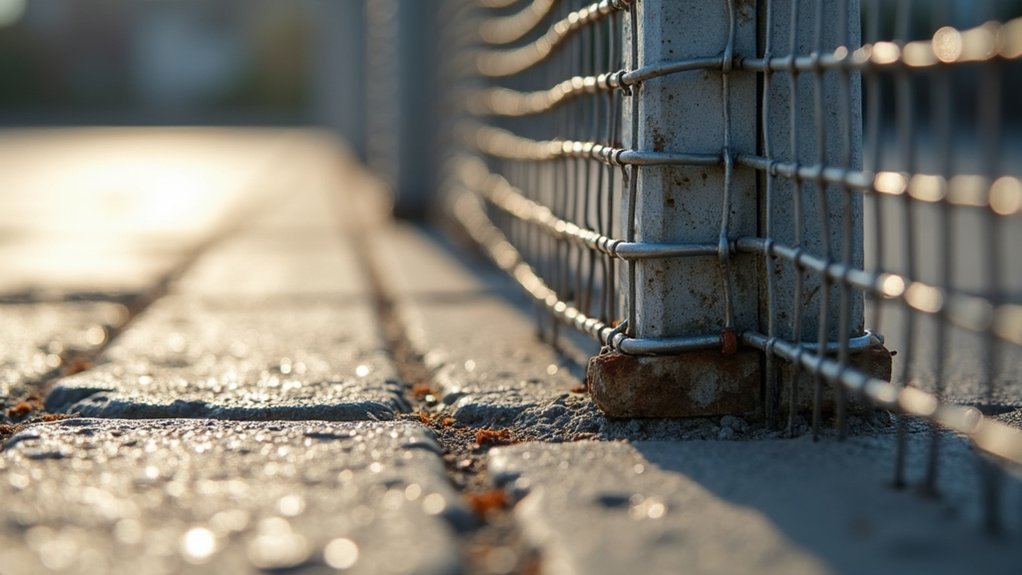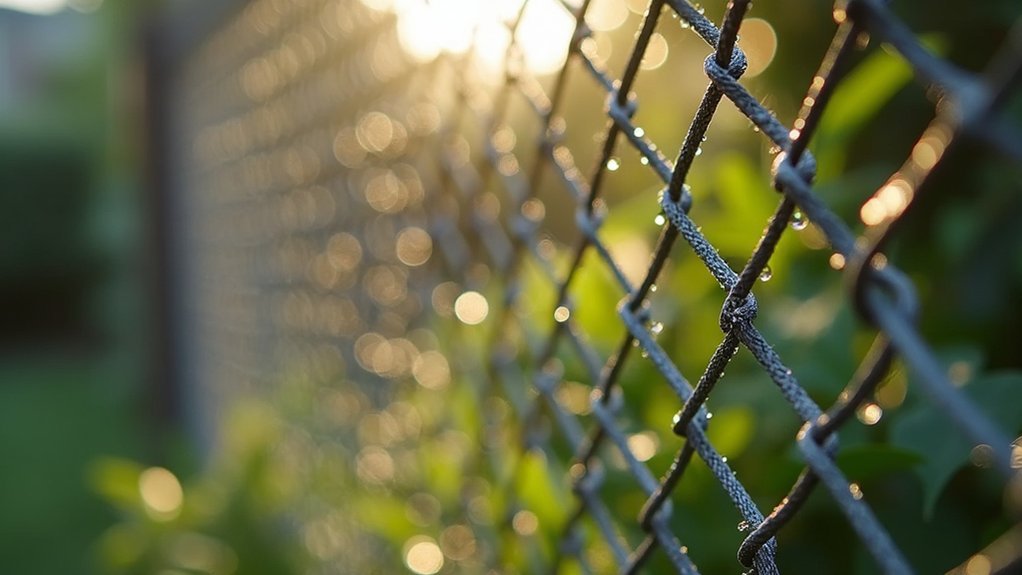Effective rodent mesh barriers include galvanized steel, stainless steel, and copper mesh with holes no larger than 6mm. You’ll need to identify all entry points—including vents, pipe entries, and tiny gaps as small as 2cm for mice. Install mesh at least 4-6 inches underground to prevent burrowing. For lasting protection, combine mesh with sealed cracks, natural repellents, and regular inspections. The right mesh material and installation technique makes all the difference in keeping rodents out.
Essential Materials for Effective Rodent Mesh Barriers

Durability forms the foundation of any successful rodent defense system.
When selecting mesh barriers for rodent control, you’ll want to prioritize galvanized steel mesh for its impressive 10-20 year lifespan and superior resistance to rust and corrosion.
Stainless steel mesh with 2mm or smaller holes prevents determined rodents from chewing through your defenses.
For additional protection, copper mesh serves as a natural deterrent thanks to its antibacterial properties that rodents avoid.
Heavy-duty welded wire mesh offers adaptability for various entry points while maintaining robust protection.
Remember to choose non-toxic materials for your mesh barriers to guarantee safety for your family, pets, and environment while effectively blocking pest entry.
This combination of strength and safety creates the most effective rodent prevention system.
Identifying Critical Entry Points for Mesh Installation
You’ll need to carefully check your property for the smallest openings, as mice can squeeze through gaps as tiny as 2cm and rats through spaces of 2.5 to 3.8cm.
Focus first on vents, air bricks, pipe and cable entry points, door gaps, and windows, which are the most common rodent access routes into buildings.
Regular inspections of both exterior and interior walls will help you catch newly developed openings before they become highways for unwanted pests.
Common Rodent Entryways
When securing your home against rodent invaders, identifying all potential entry points is the crucial first step before installing any mesh barriers. Mice can squeeze through openings as small as 2cm, while rats need just 2.5-3.8cm gaps to gain access to your property.
Pay close attention to gaps around pipes, cables, vents, and doors—these are prime rodent entryways that require effective mesh installation.
Don’t overlook air vents and air bricks, which provide necessary ventilation but can become unwanted access points if left unprotected.
To prevent rodent intrusions, install mesh barriers with holes no larger than 6mm over all potential entry points.
Regular inspections are essential, as even seemingly insignificant gaps can provide access routes for determined rodents if not properly sealed.
Prioritizing Vulnerable Areas
Once you’ve identified potential entry points, the next step involves strategically prioritizing the most vulnerable areas of your home for mesh barrier installation.
Focus first on openings around utility penetrations where pipes and cables enter your structure—these are prime rodent highways. Air bricks require immediate attention; secure them with durable metal mesh to maintain ventilation while preventing rats from squeezing through.
Remember that mice can slip through gaps as small as 2cm, while rats need only 2.5-3.8cm. When implementing rodent control measures, guarantee proper installation of steel mesh over these vulnerable areas, leaving no openings larger than 6mm.
Pay special attention to door gaps and vents, which frequently offer easy access. Establish a schedule for regular inspections of your mesh barriers to maintain their integrity, as deterioration can quickly compromise your prevention efforts.
Proper Sizing and Selection of Rodent-Resistant Mesh

Selecting the right mesh is essential for creating an effective barrier against persistent rodent invaders. Choose stainless steel mesh with 2mm or smaller holes for areas with aggressive chewers, or opt for galvanized welded wire mesh that offers 10-20 years of corrosion-resistant protection.
Remember that proper rodent exclusion requires holes no larger than 6mm, as rats and mice can squeeze through surprisingly small openings.
For successful pest control implementation:
- Measure entry points precisely and utilize custom sizing options
- Secure all edges of the mesh with no gaps for complete rodent exclusion
- Install the durable material with overlapping seams to prevent exploitation
- Consult experts about specific mesh types based on your local rodent species
Installation Techniques for Underground Mesh Perimeters
Determined rodents will often burrow their way onto your property if barriers exist only above ground. To prevent this, install underground mesh at a buried depth of 4-6 inches around your perimeter. This depth effectively blocks digging rodents from accessing your enclosure.
Always use a continuous sheet of mesh covering the entire bottom area, as any gaps provide potential entry points. Secure edges tightly to the ground, creating an impenetrable seal that prevents resourceful rodents from exploiting weaknesses.
Any gap in your mesh barrier creates an invitation for rodents—install continuous sheets and secure all edges for truly effective protection.
For enhanced protection, consider horizontally layering mesh under the grass, which provides additional security while maintaining landscape aesthetics.
Don’t neglect regular inspection of your underground mesh installation—checking for damaged sections and maintaining its integrity guarantees long-term effectiveness against persistent rodent invaders.
Securing Mesh at Building Junction Points and Openings

Junction points where walls meet foundations and utility openings represent the most vulnerable areas for rodent infiltration on your property.
To guarantee effective rodent entry prevention, install galvanized mesh with opening sizes no wider than 6mm at these critical building junction points. Your mesh barriers should be firmly attached with screws or clips to provide long-lasting protection.
- Position welded mesh on the inside of air bricks where rodents can’t access it for chewing.
- Secure each edge of the mesh with at least three attachment points to prevent sagging or displacement.
- Overlap mesh sections by at least 5cm at connection points to eliminate potential gaps.
- Install inspection panels where appropriate to facilitate regular inspections without compromising barrier integrity.
Weather-Resistant Mesh Options for Outdoor Applications
When choosing mesh barriers for outdoor rodent exclusion, you’ll find galvanized steel mesh offers exceptional durability and corrosion resistance even in harsh weather conditions.
UV-treated plastic screens provide a lightweight alternative that won’t deteriorate under constant sun exposure while maintaining effective pest protection.
You should match your mesh selection to your specific outdoor environment, considering factors like rainfall, temperature fluctuations, and exposure to direct sunlight to guarantee long-lasting performance.
Galvanized Steel Durability
The remarkable durability of galvanized steel mesh makes it a standout choice for outdoor rodent barriers.
You’ll benefit from its impressive 10-20 year lifespan, thanks to superior rust resistance that withstands challenging weather conditions.
When selecting mesh for your outdoor applications, consider that the wire diameter (typically 0.025-0.032 inches) provides ideal structural integrity while effectively preventing rodent entry.
- Custom-fit barriers that seal even irregular openings, eliminating potential entry points
- Silvery zinc coating that creates an impenetrable shield against moisture and corrosion
- Rigid yet malleable construction that maintains its shape while conforming to your specific needs
- Weather-beaten performance that continues to protect your garden or outbuildings season after season
Regular maintenance guarantees this reliable solution remains effective against persistent rodent intruders.
UV-Treated Plastic Screens
Beyond galvanized steel options, UV-treated plastic screens offer impressive weather resistance with distinct advantages for outdoor rodent barriers.
These weather-resistant barriers resist fading and degradation from sunlight exposure while effectively supporting rodent exclusion efforts.
You’ll appreciate the fine mesh structure that prevents even small rodents from entering while maintaining good air circulation and visibility.
Their lightweight and flexible nature makes them easy to cut and shape for various outdoor applications, adapting to different openings with minimal effort.
Unlike metal alternatives, UV-treated plastic screens remain non-corrosive and rust-proof throughout their lifespan, eliminating frequent replacement concerns.
For thorough pest control, combine these screens with additional physical barriers, as particularly aggressive rodent species might attempt to breach weaker materials in your exclusion system.
Combining Mesh Barriers With Other Exclusion Methods
While mesh barriers provide an excellent physical obstacle for rodents, combining them with complementary exclusion techniques creates a thorough defense system against unwanted invaders.
For effective exclusion methods, you’ll need to implement integrated strategies that address multiple vulnerabilities in your property.
- Seal all gaps and cracks around your foundation, walls, and utility penetrations with appropriate materials to eliminate entry points that bypass your mesh barriers.
- Apply natural repellents like peppermint oil around perimeters to create an additional sensory deterrent.
- Implement vegetation management by trimming plants away from structures and removing debris that could house rodents.
- Establish monitoring systems with strategically placed traps to track rodent activity and reduce populations while your pest-proof barriers prevent new invasions.
Regular inspections guarantee your integrated rodent control system maintains its effectiveness.
Maintenance and Inspection Protocols for Long-Term Protection
Even the best mesh barriers require ongoing attention to maintain their effectiveness against determined rodents. Conduct thorough inspections at least every six months to identify wear and damage that could create entry points. Pay special attention to seams and edges, making sure they’re securely fastened with no gaps larger than 6mm.
| Maintenance Task | Frequency | Purpose |
|---|---|---|
| Visual inspection | Bi-annually | Identify damage or gaps |
| Check for rodent activity | Monthly | Detect droppings or chew marks |
| Clean mesh surfaces | Quarterly | Remove debris affecting function |
Watch for signs of rodent activity around your barriers, as these indicate areas needing reinforcement. Regularly clean the mesh to prevent ventilation blockage and maintain airflow. Replace sections showing rust and corrosion promptly, particularly with galvanized steel mesh, to guarantee long-lasting protection against persistent pests.
Frequently Asked Questions
What Mesh Can Rats Not Chew Through?
Rats can’t chew through stainless steel mesh with holes of 2mm or less, galvanized welded wire mesh, or copper mesh. You’ll need to guarantee proper installation, as they’ll exploit any gaps you leave.
What Is the Best Rodent Barrier?
Stainless steel and galvanized welded wire mesh with holes 2mm or smaller are your best rodent barriers. They’re chew-resistant, durable, and effective when properly installed with no gaps. Consider copper mesh for its repellent properties too.
What Mesh Prevents Rodents?
To prevent rodents, you’ll need stainless steel mesh with 2mm holes, galvanized welded wire for larger rats, or copper mesh which naturally repels them. Don’t forget to secure properly with no gaps above 6mm.
What Size Mesh to Keep Rodents Out?
You’ll need mesh with holes of 2mm or smaller to keep out all rodents. For larger openings, 6mm RatMesh works well. Remember, mice can squeeze through 2cm gaps and rats through 3.8cm openings.
In Summary
You’ll find that mesh barriers are only effective when you’ve selected the proper gauge, installed it correctly at all entry points, and regularly inspect for damage. Don’t forget to combine your mesh defenses with other exclusion methods for thorough protection. With weather-resistant materials and proper anchoring techniques, you’ll create a rodent-proof perimeter that protects your property for years to come.





Leave a Reply